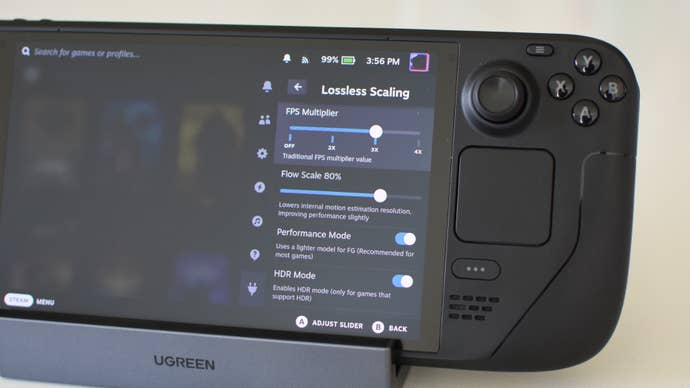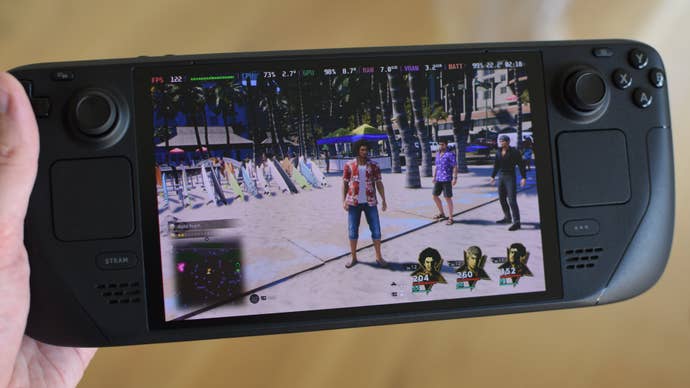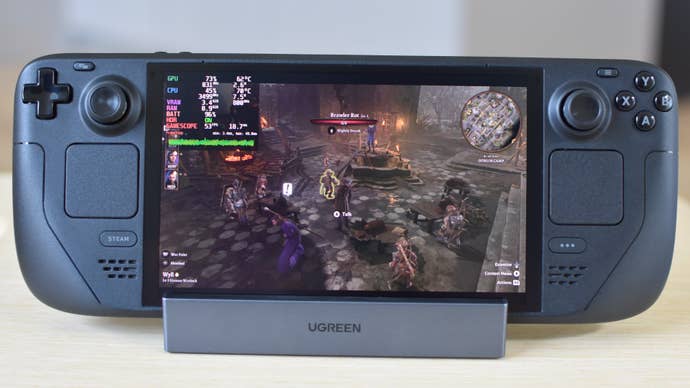Over the previous week or so, Steam Deck circles have been stuffed to their plastic curves with chatter over Decky Lossless Scaling: a plugin for the hand held’s Decky Loader toolbox that makes the game-agnostic body era of Lossless Scaling work, kind of, within the Deck’s predominant Gaming Mode. Fairly the feat, contemplating Lossless Scaling itself is formally unsupported on SteamOS.
In fact, it is a veritable Russian doll of unofficial spinoff initiatives. The plugin, by developer xXJSONDeruloXx, relies on the separate LSFG-VK by PancakeTAS, which is in flip a Linux compatibility layer for the unique, Home windows-based Lossless Scaling (and, whereas I’m crediting people, a nod additionally goes to YouTubeist Deck Wizard for pointing this all out first). The lengthy and in need of it’s that after the whole lot is about up, you may make your Steam Deck do its finest DLSS 4 impression by making an attempt to double, triple, or probably quadruple the framerate output in your alternative of video games – although having tried it in a number of myself, I’m not satisfied you’ll all the time wish to.
The Steam Deck might, to make sure, use a hand protecting its frames counts up. Different handheld PCs routinely outperform it and loads of fashionable, high-fidelity video games are unable to adequately run in any respect. Body era doesn’t really increase efficiency, solely including algorithm-spun approximations of recent frames in-between the actual ones, however the body gen tech served up by DLSS, FSR, XeSS on desktops can look visually convincing in the suitable situations. Who might blame a Deck proprietor, dwelling hand to mouth on 30fps scraps, for taking over this provide of a free lunch?

Particularly when, in at the least some video games, it sorta-kinda-maybe does the trick. Even on Low settings with Efficiency-level FSR upscaling, Doom: The Darkish Ages’ framerate falls into the twenties with sufficient regularity that Valve deemed it Unsupported on the Steam Deck. However, after making use of Lossless Scaling on 3x mode, it normally stored above a easy 60fps, peaking at 80fps and solely falling so far as 55fps throughout a very explosion-ridden bit. Whereas the true body depend was probably extra within the 25-35fps vary, and body gen did diddly squat to enhance aiming responsivity, my eyes have been efficiently tricked into seeing The Darkish Ages as working smoother than it actually was. I’d undoubtedly contemplate it playable, particularly after enabling the plugin’s Mailbox Vulkan override, which disables V-Sync to counteract the enter lag that body era naturally provides.
Higher but was Like a Dragon: Infinite Wealth. On its Medium preset, I received between 36fps and 45fps whereas mooching across the Hawaii open world, rising to 91-124fps with 3x body gen. That’s so excessive that my Steam Deck OLED’s refresh charge couldn’t even show all of them, and once more, there was a transparent improve to visible smoothness. If there was an enter lag bump, it was additionally a lot simpler to disregard on this turn-based roleplayer than with Doom’s snap-aim shootery.

Alas, not all body gen tales have comfortable endings. Elden Ring feels like a major candidate for this kind of factor: it’s fairly often pressured all the way down to 30fps on the Medium preset I examined at, typically barely decrease specifically components of the open world, so multiplying that output ought to theoretically ship a really noticeable sprucing. Sadly, and regardless of utilizing the plugin’s really helpful settings (Efficiency mode with Movement Scale set to 80%, if you wish to do this at dwelling), frame-genned Elden Ring by no means really seemed as easy because the numbers suggesting it ought to have. On my authentic LCD Steam Deck, 3x mode was filling out the 60Hz refresh charge, but I might solely understand a really modest slickness enhancement, and after switching to the 90Hz OLED mannequin, a 74-90fps depend nonetheless solely seemed like 50-60fps in movement.
As with earlier variations of AMD’s FSR 3 body gen, inconsistent body occasions are the prime suspect for this odd mismatch between framerates and last visuals. Body occasions are the lengths of the gaps between every new body being proven, and in the event that they’re not constant, you find yourself with stuttering or jittery digital camera motion of the kind I’d seen right here.
Nonetheless, Elden Ring at the least fared higher than Baldur’s Gate III. Not solely did this obtain the thinnest smear of additional frames – 40-50fps, on Medium high quality with High quality FSR upscaling, rose to only 49-56fps on 3x mode – nevertheless it was additionally riddled with visible artifacts and glitchy body gen errors, significantly across the edges of the display screen. I attempted to therapeutic massage the numbers extra deeply by switching to 4x mode, however this barely received BG3 throughout the 60fps line, whereas worsening the artifacts and completely drowning the controls in enter lag molasses. Which, not like in Infinite Wealth, have been sticky sufficient to actively annoy.

What’s worse is that I used to be fairly hopefully for BG3 after its pre-frame gen check run, as body era works normally finest with video games that may already pump out a good measure of normal frames by themselves. That not solely permits for a lot larger complete body counts, after the interpolation trick is pulled, however helps maintain latency down as nicely. It clearly didn’t occur right here, thoughts, which you’ll most likely take as affirmation that actually “for any sport” body era remains to be some methods off.
To be truthful, each the Decky plugin and the compatibility layer it’s based mostly on are in ongoing improvement: once I first put in Decky Lossless Scaling final Friday, it was on v0.3.1, and once I got here again to it this Monday morning, it had superior seven public variations to v0.6.7, gaining a handful of recent settings and quality-of-life options alongside the best way. Between this tempo of change and lsfg-vk’s personal progress, it’s very probably that sport compatibility will enhance. I’ll be protecting an eye fixed out for the plugin’s v1.0 launch for that purpose, although proper now, it feels extra like an intriguing experiment than a vital Steam Deck improve on par with Luter. Or, certainly, Decky Loader itself.